
Chinle tours flood site with federal officials as it continues development of emergency action plan
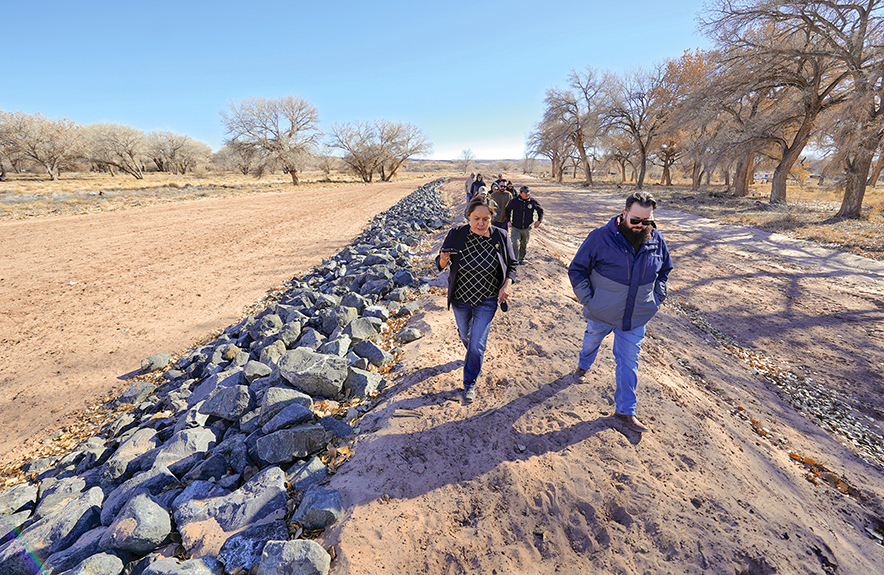
Special to the Times | Donovan Quintero
Chinle Chapter President Rosanna Jumbo-Fitch, left, walks with Christopher Stanton from the U.S. Army Corps of Engineers, right, on Tuesday, Dec. 10, as they do a tour of an area that was devastated by floods in 2023, in the Chinle Wash in Chinle. A berm about three miles long was constructed and designed to protect Chinle residents living along an area called “Jurassic Park.”
CHINLE
In the wake of a devastating 2023 flood that ravaged this community, Chinle Chapter President Rosanna Jumbo-Fitch met with representatives from the U.S. Army Corps of Engineers this week to discuss the chapter’s emergency response efforts and the need for long-term flood mitigation strategies.

Special to the Times | Donovan Quintero
Christopher Stanton from the U.S. Army Corps of Engineers looks at an area where a berm was constructed and designed to protect Chinle residents on Tuesday, Dec. 10, in Chinle.
The meeting, held at the site of the Chinle Wash, provided a sobering look at the challenges faced by Chinle residents when floodwaters as high as four feet inundated homes and threatened lives last year.
“We had a small group of chapter staff and local youth working around the clock to try and hold back the flood,” Jumbo-Fitch recounted. “They were filling sandbags, building temporary berms, and doing everything they could to protect the community.”
Jumbo-Fitch met with Chris Stanton, Grant Adams, Jonathan Hallemeier, and Aaron Flammang, all with the U.S. Army Corps of Engineers on Tuesday at Chinle Wash to further ongoing discussions about creating an emergency action plan to prepare for and mitigate flooding risks.
Enhancing flood resilience, strengthening berm
Jumbo-Fitch explained that the visit was part of the Army Corps’ Silver Jackets program, which collaborates with local communities to enhance flood resilience.
“We’re obviously at the top of the radar with all the significant flooding we’ve experienced, especially last April,” she said. “The Army Corps brought in experts from Los Angeles, Sacramento, Albuquerque, and the L.A. District to evaluate and assist.”
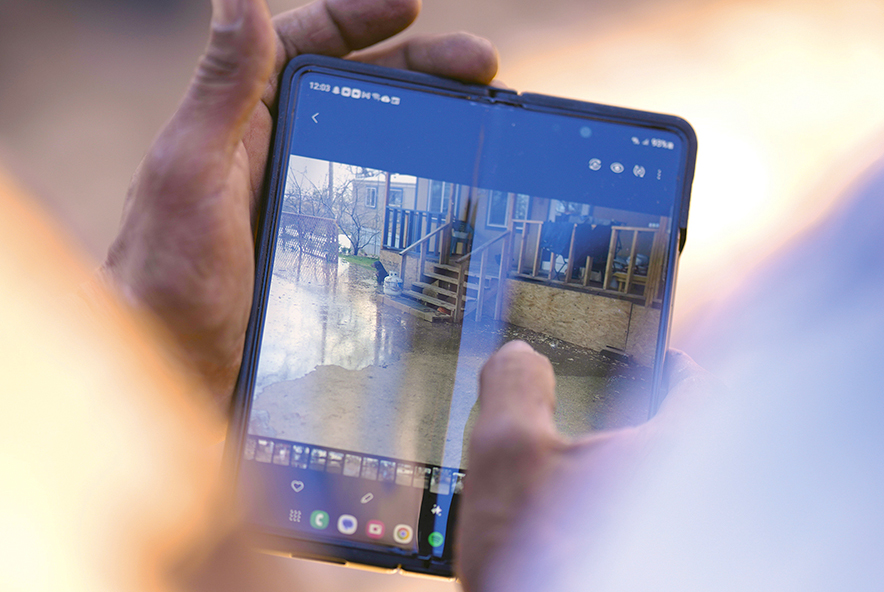
Special to the Times | Donovan Quintero
Dwayne Kinlichee from Chinle shows Christopher Stanton from the U.S. Army Corps of Engineers flood waters that flooded his home in Chinle. Kinlichee told Stanton the floods took nearly two weeks to recede and weeks for it to dry.
The discussions focused on three main areas: installing water monitoring gauges, implementing an alarm system, and reviewing existing flood mitigation measures.
The chapter is working on installing gauges to track water flow in Chinle Wash.
“They want to ensure the gauges are effective and not prone to vandalism,” Jumbo-Fitch noted. The Army Corps also proposed installing an alarm system on a nearby hill to alert residents of incoming high-velocity water. “This would allow immediate notification without waiting for emergency management or chapter officials to respond.”
During the site visit, participants reviewed the rock weirs and temporary berms constructed after the April 2023 flood. These measures, including sandbagging and the installation of Hesco baskets, provided critical protection during the emergency. However, Jumbo-Fitch acknowledged that the work was only a temporary solution.
The Army Corps recently wrapped up 110 days of repairs to strengthen the berm.
“These advanced measures were funded by the Army Corps, but they are not enough to guarantee long-term safety,” she said. To address this, the chapter is planning a Tribal Partnership Project to design a permanent solution.
Personal accounts, site visit
Residents like the Crosby family, who were severely impacted by past floods, provided feedback during the visit.
“They shared photos, videos, and personal accounts of flooding in 2021 and 2023, emphasizing how debris and sediment trapped them in their homes,” Jumbo-Fitch said. Their property now borders Chinle Wash, with only the repaired berm offering protection.
In the wake of the devastating floods that have plagued the region, community leaders and federal representatives gathered for a site visit to assess damages and discuss future emergency response plans.
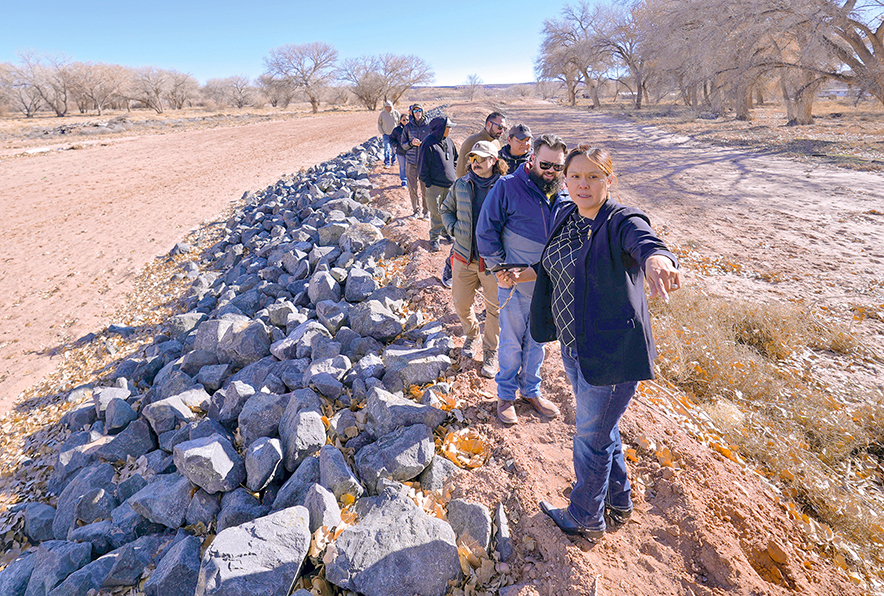
Special to the Times | Donovan Quintero
Chinle Chapter President Rosanna Jumbo-Fitch walks as she describes where the berm goes while doing a tour with Christopher Stanton from the Army Corps of Engineers on Tuesday, Dec. 10, in Chinle.
Jumbo-Fitch introduced Army Corps of Engineers representative Christopher Stanton to community member Dwayne Kinlichee and his mother, Patricia Crosby, as they walked along the flooded berms.
“The Army Corps is here, along with a couple of gentlemen from our emergency management team. They want to get some information from residents like you,” Jumbo-Fitch explained. “Their emergency action plan takes into account our experiences during the flood, what we want moving forward, and what resources we needed during and after the disaster.”
The group navigated through the remnants of the flood’s devastation of a debris-strewn landscape marking the landscape.
“We’ve done some repairs from last year’s flooding, but they’re eager to hear about your experiences. Anything you can share will help us better respond next time,” said Jumbo-Fitch to Kinlichee.
Stanton provided insight into the collaborative efforts underway, highlighting the formation of the Navajo Nation Silver Jackets team, which includes federal and state agencies such as FEMA and the Army Corps, all working together to support tribal interests.
“You, as residents and tribal members, will guide us on what projects you want to be implemented and how we should approach those projects,” Stanton said. “We need to learn from your experiences. How have you dealt with emergencies in the past? What worked well for you?”
As Kinlichee recounted his experiences over the past two decades living in Chinle, he illustrated the severe impact of the floods.
“I’ve been here for more than twenty years now,” he stated. “It’s probably our fourth time getting hit by floods. The first time, it broke three times. It went down this way, and then the fourth one was way down there, hitting my place real bad.”
Torrent of water
Gesturing at the landscape, Kinlichee recalled the staggering heights the water reached.
“The water reached up to here,” he indicated with his hand, “My trailer was kind of floating, and all those wedges were apart. So, I just want that water to stop, and I don’t know what you guys can do about it.”Kinlichee vividly described the progression of the flooding.
“It started slowly at first, but by nightfall, it quickly became a torrent of water. It took about a week and a half for the flooding to recede and even longer for the area to dry out.”
He explained that the source of the floods originated from the Chuska Mountains, about 30 miles east of Chinle, where melting snow would rush down into the canyon, exacerbating the flooding in the valley below.
Patricia Crosby also provided comments and spoke with heartfelt emotion about the impact of the recent floods on her community. In her remarks in Navajo, she emphasized that “the floods used to be small until two years ago when they flooded our home.”
“It hit us hard, and our homes were almost destroyed. Floods are very scary,” said Crosby.
Crosby also expressed gratitude for the support from the Chinle Chapter.
“With their help, we’ve been sleeping more soundly despite the challenges we face,” she said.
Crosby’s laughter highlighted her strength and resilience, seeming to showcase a spirit that refuses to be broken by adversity.
Crosby extended her thanks to the outgoing chapter president and the Army Corps of Engineers.
Stanton listened intently, recognizing the value of Kinlichee’s and Crosby’s firsthand accounts as his team gathered the stories.
To ensure the success of these emergency measures officials have been working on, Jumbo-Fitch stressed the importance of community cooperation.
“We talked about the human influence,” she said. “The main concern is keeping people from disturbing what’s been installed. We can’t control free-roaming livestock, but we can encourage residents to be mindful. It costs millions to repair these structures, and their efforts are needed to ensure their protection.”
Maintaining momentum
As Jumbo-Fitch prepares to hand over leadership to incoming chapter president Paul Guy Jr. in January, she emphasized the importance of maintaining momentum.
“We’ve made significant progress in the last three and a half years,” she said. “If we drop the ball now, the community will face major risks. Right now, we have the attention of the federal government and the opportunity to secure funding and engineering support. This partnership has never progressed this far before.”
She expressed hope that the new administration would prioritize flood protection.
“It would be a monumental achievement to complete this project and provide lasting security for the community,” she said.
Despite their valiant efforts, the sheer volume of water overwhelmed the makeshift defenses, causing extensive damage to 79 homes and infrastructure. Jumbo-Fitch noted that some residents had to be rescued from their flooded properties, while others lost livestock and personal belongings.
The Army Corps representatives listened intently, acknowledging the community’s resilience in the face of such a devastating event. They pledged to work closely with the Chinle Chapter to develop a comprehensive emergency action plan and explore long-term flood mitigation strategies.
“It’s clear that the frequency and intensity of these flood events are increasing, and we need to be better prepared,” said Stanton. “We’ll be working with the chapter to identify vulnerable areas, strengthen flood control measures, and provide training to the community on emergency preparedness.”
Increased sedimentation, climate change
Northern Arizona has been facing a growing challenge as overgrazing contributes to frequent and severe flooding, according to environmental expert Stanton. He outlined how the detrimental practice of overgrazing has led to increased sedimentation in local waterways, exacerbating flooding events across the region.
“Overgrazing loosens up the soils, making them more susceptible to erosion,” Stanton explained. “When water flows over these compromised areas, it dislodges significant amounts of sediment, which ends up clogging rivers and streams.”
The issue, he noted, is not limited to northern Arizona; it has affected various parts of the southwestern United States since the 1970s. Reports from that era highlight a dramatic change in the landscape because of unchecked grazing, leading to increased erosion and further complicating flood management.
“While some sedimentation is beneficial for the ecosystem, the excessive amount we’re seeing today is problematic,” Stanton emphasized.
He pointed out that heightened sediment levels pose serious risks by accumulating under bridges, effectively transforming them into makeshift dams. This blockage forces water to divert to alternative paths, leading to flooding in surrounding areas.
Stanton cited examples from recent history, including incidents in Birdsprings, Arizona, near Leupp, and on the Hopi reservation, in communities like Polacca and Moenkopi, where they’ve faced recurring flooding because of these changes. The floodwaters often inundate infrastructure and homes, creating ongoing hardships for residents.
The problem is compounded by invasive plant species such as tamarisk, which also contribute to sediment buildup. Stanton referenced a situation in Duncan, Arizona, where tamarisk growth has similarly led to increased flooding risk by obstructing waterways.
“The river systems are filling up with sediment, and this results in water seeking the path of least resistance,” Stanton said. “When natural flow patterns are disrupted, we see more flooding occurrences, threatening both human settlements and local ecosystems.”
While the effects of climate change further strain the environment, the need for sustainable land management practices has become increasingly urgent, said Stanton.
With the realities of a changing climate and its implications for natural disasters, understanding the relationship between land use practices and environmental degradation is vital. Addressing overgrazing may provide a crucial step toward safeguarding communities against future floods.
Community involvement, education
Jumbo-Fitch welcomed the partnership, emphasizing the importance of community involvement and education in the process. She recounted how local youth had stepped up to assist during the crisis and expressed a desire to build on that momentum through workshops and hands-on training.
“Our people have a deep connection to this land, and they want to be part of the solution,” Jumbo-Fitch said. “By working together with the Army Corps and other agencies, we can develop sustainable flood management strategies that protect our homes, our livelihoods, and our way of life.”
The group walked the length of the Chinle Wash, surveying the damage and discussing potential restoration efforts. All agreed that the path forward would require a collaborative approach, drawing on the expertise of engineers, ecologists, and the community itself.
“This is not just about building bigger walls or dams,” Stanton said. “It’s about understanding the entire ecosystem, respecting the power of nature, and empowering the people who call this place home. That’s the only way we’ll truly be prepared for the next flood.”
Going into 2025, the U.S. Southwest, including Arizona, Utah, New Mexico, and Colorado, is poised for a winter marked by warmer-than-average temperatures and drier conditions, according to the National Oceanic and Atmospheric Administration, or NOAA. The forecast, influenced by the return of El Niño, reflects a shift in climate patterns that could have significant impacts on the region.
El Niño, characterized by warmer waters in the Pacific Ocean, often disrupts typical weather patterns across the United States. In the Southwest, the NAOO cites that El Niño’s influence will lead to reduced snowfall and below-average precipitation, particularly in Arizona and New Mexico. The region has already been facing persistent drought conditions for more than 25 years, where water supplies are heavily reliant on seasonal snowfall.
In Colorado and Utah, the effects may vary depending on location. Northern parts of these states could see increased precipitation because of their proximity to wetter northern regions, while southern areas are more likely to experience the dry conditions anticipated for much of the Southwest, states NAOO. Across all four states, warmer temperatures could further impact snowpack levels, which are critical for water storage and management.
The tour concluded with Jumbo-Fitch reminding the Army Corps of Engineers team it would be working with a new chapter administration in January.
“I hope the next administration takes the consideration seriously as far as providing that protection to the community,” she said.

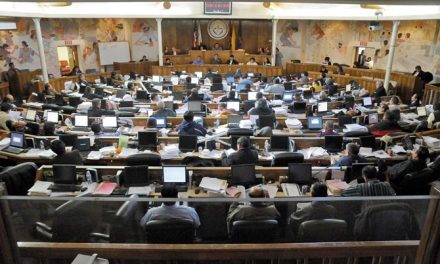
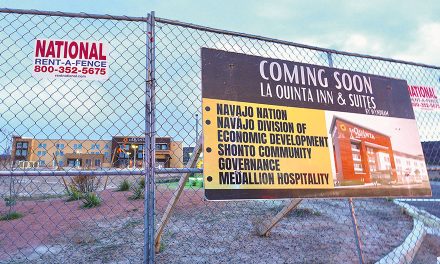

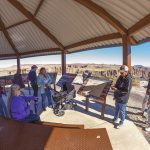



 Highway 264,
Highway 264, I-40, WB @ Winslow
I-40, WB @ Winslow